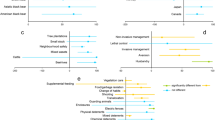Abstract
Protected from hunting and provided with access to water-holes during droughts, elephant numbers can double in a decade, severely damaging natural vegetation and the many species dependent upon it. Culling is an effective but controversial control strategy, so Fayrer-Hosken et al.1 have assessed the efficacy of using immunocontraception through vaccination, concluding that this could be a practical way of controlling elephant numbers. However, an intervention feasible in reproductive physiology may not be a practical way to control a population. Fayrer-Hosken et al. have not considered calculations2,3 that undermine the practicality of their method, nor alternative management strategies.
Similar content being viewed by others
Main
Controlling elephants in Kruger National Park, South Africa, by immunocontraception would necessitate treatment of 2,250 cows each year over an initial period of 11 years (ref. 3). Even if individual treatments were 100% effective, the costs would be likely to exceed the total management budget of the South African national parks. The best results of Fayrer-Hosken et al. involved two of ten elephants becoming pregnant, and that was after receiving two booster vaccinations.
The effectiveness of this method may be less than claimed. Of the control group, 89% became pregnant within a year. This seems high, exaggerating the difference between treated and control groups. Data from 813 adult cows culled in Kruger National Park between 1979 and 1994 showed that 51% (range, 36–77%) were pregnant. This is to be expected: gestation lasts 22 months and the calving interval is 44 months (ref. 2), so about 50% of a sample of cows should be pregnant. Thus, on average, females go for 22 months without becoming pregnant. In a random sample of females monitored for 12 months, only 55% (not 89%) should therefore become pregnant.
Between 16 and 1,846 elephants of all age classes and both sexes were culled annually in Kruger National Park from 1967 to 1994. We share the desire to reduce culling and have sought methods to do so. Removing or sterilizing 250 subadult females each year should reduce population growth to zero2,3. Moreover, densities of greater than 0.37 elephants per square kilometre result in reduced population growth rates — probably due to reduced reproductive output by newly sexually matured females or to increased calving intervals2. Culling, as conducted, maintained densities at which population growth was near its maximum. Culls should be delayed for one year after counts exceed 0.37 elephants per square kilometre to allow density dependence to reduce numbers naturally2. Culls may still be necessary, but they would then be much less frequent and involve far fewer animals.
References
Fayrer-Hosken, R. A., Grobler, D., Van Altena, J. J., Bertschinger, H. J. & Kirkpatrick, J. F. Nature 407, 149 (2000).
van Aarde, R. J., Whyte, I. & Pimm, S. Anim. Conserv. 2, 287–294 (1999).
Whyte, I., van Aarde, R. J. & Pimm, S. Anim. Conserv. 1, 77–83 (1998).
Author information
Authors and Affiliations
Corresponding author
Rights and permissions
About this article
Cite this article
Pimm, S., van Aarde, R. African elephants and contraception. Nature 411, 766 (2001). https://doi.org/10.1038/35081154
Issue Date:
DOI: https://doi.org/10.1038/35081154
This article is cited by
-
Effect of the CITES trade ban on preferences for ivory in Japan
Environmental Economics and Policy Studies (2020)
Comments
By submitting a comment you agree to abide by our Terms and Community Guidelines. If you find something abusive or that does not comply with our terms or guidelines please flag it as inappropriate.



